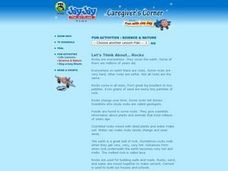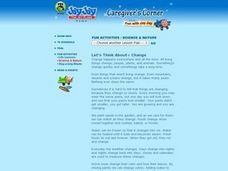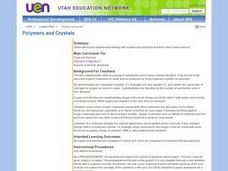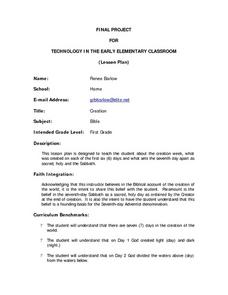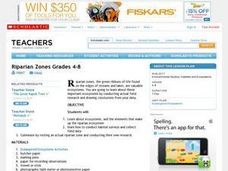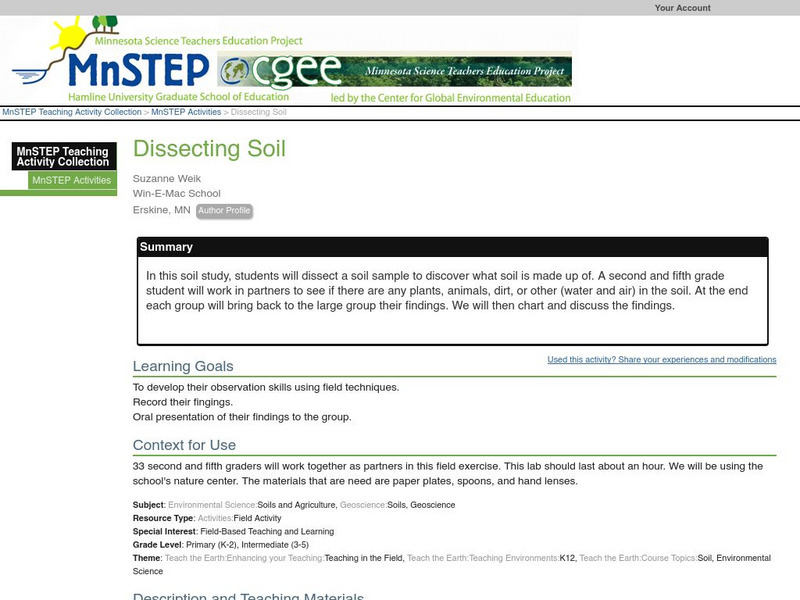Curated OER
Science: What Is the Carbon Cycle?
Students examine the carbon cycle while identifying its sources, sinks, and release agents. Using magazines and newspapers, groups of students design collages illustrating the carbon cycle. Finally, they write responses to several...
Curated OER
Don't Marry the Mole!
Third graders examine the power of solar energy. In groups, they create their own pizza box solar oven to discover the power of the sun and how it is a source for heat and light. To end the instructional activity, they use the internet...
Curated OER
Dissolved Oxygen Lesson
Students investigate what dissolved oxygen is and why it is important to aquatic life and what factors influence levels of dissolved oxygen in a lake. They study how to use MS Excel to make charts to show trends and correlations.
Curated OER
Math: Counting on Others
Students use counting skills to decide who wins the Classroom Winter Games. They use numeral writing and tally marks to keep score. Students have an opportunity to pretend they are competing for medals in the Winter Games while using...
Curated OER
But I Need This
Third graders place everything in their desk or back pack onto their desk top. They explain why each item is needed. They receive a set of pictures and write a list of things each person or animal needs to survive. They compare people,...
Curated OER
Let's Think About... Change
Students observe various examples of "change." They mix paint to cereate new colors, eat bread and then toasted bread, and match baby pictures with pictures of how the same people look in the present. Finally, they watch a bouquet of...
Curated OER
Whales
Students compare and contrast the two types of whales. In this biology instructional activity, students research the characteristics of their assigned whale. They compile their findings in a folder.
Curated OER
Polymers and Crystals
High schoolers experiment with crystals and polymers and examine their roles in food science.
Curated OER
Where Are the Dinosaurs?
Young scholars explore what the dinosaurs were like. In this dinosaur lesson, the teacher peaks student curiosity about dinosaurs. This lesson would be a great starting point for a dinosaur unit since it primarily engages student...
Curated OER
Rikki-Tikki Research
Fourth graders perform a search on mongooses on Internet Explorer and answer research questions.
Curated OER
Solar Matters
Students design an energy resource wheel and demonstrate how to use it to access information about renewable and nonrenewable energy sources.
Curated OER
Technology In The Early Elementary Classroom
First graders explore the creation of the world and what was created on each specific day. They read the creation of the world from the Bible, watch a video, and sing a song about the Creator. Using Kid Pix software, 1st graders create...
Curated OER
The Formation of Soil
Students identify the different components that make up soil. In this earth science lesson, students create a pamphlet for next year's class. They analyze how erosion and weathering shape the Earth.
Curated OER
Changing How Things Look
Third graders use a literature study in order to investigate how organisms effect an ecosystem. They are asked questions about change taken from the book. Students also take a nature walk to make field observations.
Curated OER
John Muir: Long Ago and Now
Students explore nature objects brought indoors such as rocks, seeds, leaves and shells to identify where the objects came from. They hear stories about John Muir's life and make booklets about nature areas they enjoy.
Curated OER
The Appearance of the Moon
Third graders watch a demonstration on how craters were formed on the moon. Individually, they care given a set of materials that represent the moon surface and make their own craters. To end the lesson, they measure the size of the...
Curated OER
Riparian Zones Grades 4-8
Students examine and analyze the Riparian Zones found on the edges of streams and lakes. They assess why those are such valuable ecosystems and then conduct actual field research on riparian zones and conclude by drawing conclusions from...
Curated OER
Summer Scientists
In this lesson, students discuss and reocrd what makes an object living or nonliving. The students then chart the lists of living and nonliving objects. Teacher allows students oportunity to go outside and look for living and ninliving...
PBS
Pbs Learning Media: Animals and Plants Can Live in a City!
In this interactive lesson, students learn that animals need air, food, water, and shelter, while plants need air, sunlight, and water. Students watch videos and engage with drawing and sorting activities to reinforce their learning....
Science Education Resource Center at Carleton College
Serc: Dissecting Soil
In this soil study, students investigate a soil sample to discover what is inside the soil. Working in partners, they explore to see if there are any plants, animals, dirt, or other (water and air) in the soil.



